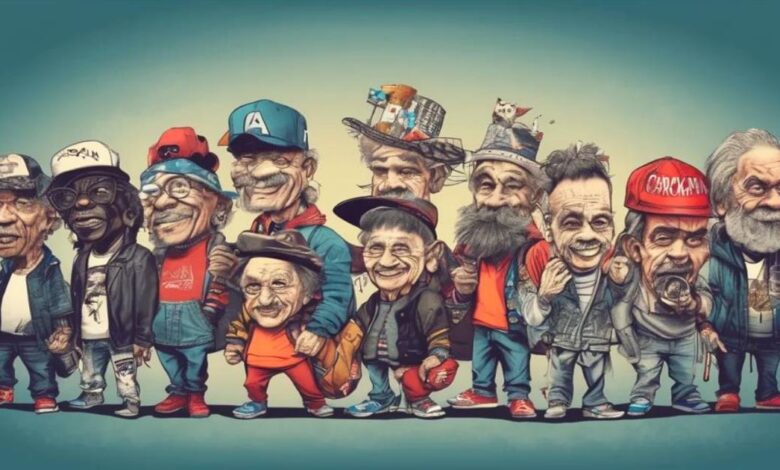Explanation of why some famous individuals have become known as famous crackheads

The term “famous crackheads” often evokes strong reactions due to the social and cultural connotations associated with it. While this colloquial term may seem pejorative, its use has gained traction in describing public figures whose lives or careers have been significantly impacted by addiction, specifically to crack cocaine or other recreational drugs. This phenomenon highlights the intersection of fame, addiction, societal stigma, and the public’s fascination with celebrity culture. The purpose of this blog post is to analyze why certain individuals, often labeled as “famous crackheads,” achieve notoriety and to explore the implications of this characterization within popular culture. By examining social, psychological, and cultural dimensions, we aim to enhance the understanding of why these individuals remain prominent in discourse.
The Origins of the Label “Famous Crackheads”
The Rise of Drug Use in Popular Culture
The increased prevalence of drug use among public figures began to gain attention in the late 20th century, during the rise of crack cocaine in the 1980s. The drug epidemic coincided with the emergence of mass media, offering unprecedented visibility into celebrities’ personal lives. Crack cocaine, due to its addictive nature and rapid effect, quickly garnered public attention, leading to its association with various social issues permeating all socioeconomic classes.
Public figures struggling publicly with addiction often became sensationalized characters within media narratives. The term “famous crackheads,” though reductive, emerged as shorthand for these individuals, encapsulating both their struggle with addiction and their notoriety within cultural discourse.
Media’s Role in Shaping the Label
The term also reflects how the media perpetuates societal stigma. Tabloids and entertainment outlets have historically exploited the hardships of public figures for profit, transforming their battles with substance abuse into headlines and gossip fodder. The framing of addiction as merely sensational rather than as a public health crisis has contributed to the normalization of referring to individuals as “famous crackheads.” Misrepresentation in media narratives often overshadows the root causes of addiction, further distorting public perceptions of both addiction and the individuals affected.
Characteristics of Public Figures Labeled “Famous Crackheads”
Socioeconomic and Career Influence
It is crucial to note that those labeled as “famous crackheads” often hail from diverse backgrounds, ranging from affluent entertainers to politically influential individuals. Among such prominent figures, the fallout resulting from addiction often varies considerably. For instance, some celebrities suffer career stagnation or public ridicule, while others may reinvent themselves, using their notoriety to champion addiction recovery and mental health advocacy.
For many, fame acts as both a protective shield and a double-edged sword. Access to wealth and resources may increase opportunities to seek professional help, but societal expectations and media scrutiny exacerbate their struggles.
Notable Examples
Several individuals stand out in discussions surrounding this label. Whitney Houston, for example, was widely regarded as one of the most iconic and talented vocalists of her generation. However, her struggles with substance abuse, and subsequent media framing, led to perceptions heavily overshadowed by her personal battles rather than her artistic achievements. Similarly, figures like Robert Downey Jr. successfully transitioned from personal turmoil to professional triumph through sustained recovery and advocacy efforts.
Others, such as comedian Richard Pryor, used humor to address their struggles, creating transparency around the issue of addiction in ways that resonated with broad audiences. Actors such as Charlie Sheen became infamous for their highly publicized battles, further cementing their association within this context.
Social and Psychological Factors Behind Addiction and Fame
The Pressure of Perpetual Public Visibility
Celebrities face unique psychological stressors inherently linked to fame. The constant scrutiny from tabloids, social media, and fans creates an environment of sustained pressure, often driving individuals to seek escapism through substances like crack cocaine. Unrelenting demands for performance, perfection, and accessibility create vulnerabilities to addiction.
The Role of Community and Enablement
Another factor lies in the permissive environments surrounding high-profile individuals, where instances of enablement by peers and associates complicate the ability to seek proper intervention. Industry culture within entertainment professions often minimizes accountability, creating compounded challenges for those attempting to combat addiction.
The Cultural and Societal Reception of “Famous Crackheads”
Socio-Cultural Commentary
The public’s fascination with celebrity struggles highlights broader cultural dynamics related to schadenfreude or the enjoyment derived from another’s misfortunes. This phenomenon is particularly evident in the consumption of entertainment media, where individuals’ personal struggles are commodified for audience engagement.
At the same time, others regard the journeys of recovery from addiction as far more admirable even inspirational. This duality reflects complex societal attitudes toward fame and vulnerability. While many see addiction narratives as cautionary tales, others view these public struggles as relatable or as opportunities to advocate for change.
Stigma versus Empathy in Public Discourse
The framing of “famous crackheads” reveals the inherent stigmatization of addiction. While the label conveys recognition of an individual’s fame, it reduces their identity to their substance use disorder, overlooking critical factors like mental health or socioeconomic contexts influencing their addiction.
Some activism and advocacy campaigns have made strides in reframing conversations surrounding addiction, prioritizing empathy, and presenting addiction as a health issue. This shift is slowly changing public narratives about individuals once deemed as “famous crackheads,” allowing for a more holistic understanding of their humanity.
Lessons and Broader Implications
Changing the Narrative About Addiction
Moving forward, addressing the narrative surrounding addiction in the context of fame requires a multidimensional approach. Society benefits from viewing addiction as a treatable condition rather than a permanent character deficit. Shaping public opinion can further reduce stigma and allow those affected by addiction to seek assistance without fear of judgment.
The Role of Advocacy by Public Figures
Many celebrities have used their fame as a platform for raising awareness about addiction. Stars like Demi Lovato and Russell Brand openly share recovery journeys to normalize discussions and destigmatize addiction. Their advocacy highlights that labels such as “famous crackheads” are insufficient descriptors of the individual experiences and complexities of addiction recovery.
Redefining Fame and Struggles
The phenomenon of “famous crackheads” underscores the complex interplay between celebrity, addiction, and societal standards. By understanding these dynamics through an objective lens, it is possible to shift public discourse, promoting greater empathy while addressing the systemic stigmatization of addiction.
Addiction is not a moral failing but a public health crisis demanding greater awareness and action. Celebrities, often inescapably intertwined with public perceptions, have the unique power to challenge stigma and drive meaningful societal change. Reframing the narrative will require societal effort—from individual attitudes to media accountability—to finally deconstruct stereotypes surrounding addiction.
FAQs
Q1.What causes addiction?
Addiction is a complex condition influenced by a combination of genetic, environmental, psychological, and social factors. It is not simply a result of personal choice but a chronic disease that affects brain function and behavior.
Q2. Why do celebrities face heightened scrutiny for addiction struggles?
Celebrities operate in the public eye, and their lives are often magnified by media coverage. This increased visibility leads to greater public judgment, which can amplify stigmatization and perpetuate harmful narratives about addiction.
Q3. Can celebrities play a role in reducing the stigma around addiction?
Yes, celebrities can leverage their influence to challenge stereotypes and advocate for understanding and reform. Their platforms give them the opportunity to spread awareness, share their experiences, and endorse resources for recovery and support.
Q4. What role does the media play in perpetuating or mitigating addiction stigma?
The media has significant power in shaping public opinion. Sensationalist reporting can reinforce negative stereotypes, while responsible journalism can foster empathy and provide accurate information, helping to redefine societal views on addiction.




One Comment